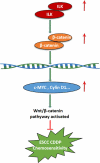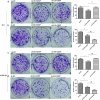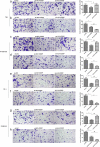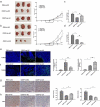Integrin-linked kinase affects the sensitivity of esophageal squamous cell carcinoma cells to chemotherapy with cisplatin via the Wnt/beta-catenin signaling pathway
- PMID: 35587162
- PMCID: PMC9275978
- DOI: 10.1080/21655979.2022.2076497
Integrin-linked kinase affects the sensitivity of esophageal squamous cell carcinoma cells to chemotherapy with cisplatin via the Wnt/beta-catenin signaling pathway
Abstract
Recent studies have shown that the expression of integrin-linked kinase (ILK) was related to the occurrence, development, and malignant progression of esophageal squamous cell carcinoma (ESCC). However, research on the relationship between ILK and the chemosensitivity of ESCC has to date not been reported. The present study found that ILK was highly expressed in ESCC cell lines, and the overexpression of ILK in ESCC cells reduced the incidence of cell apoptosis and alleviated the cytotoxicity on cells induced by cisplatin (CDDP). Inversely, ILK knockdown increased CDDP-induced apoptosis and had an inhibitive effect on the malignant phenotype of ESCC, including cell proliferation, invasion, and migration. In addition, ILK knockdown in ESCC cells inhibited the expression of beta (β)-catenin and activated the wingless/integrated (Wnt) signaling pathway. Furthermore, cellular MYC (c-MYC) and Cylin D1 were the target genes of the Wnt signaling pathway. Rescue experiments showed that the overexpression of β-catenin reversed a tumor's inhibition and apoptosis abilities induced by ILK knockdown. In conclusion, ILK potentially reduced the CDDP sensitivity of ESCC cells by influencing the activity of the Wnt/β-catenin signaling pathway.
Conflict of interest statement
No potential conflict of interest was reported by the author(s).
Figures









Similar articles
-
DCLK1 inhibition attenuates tumorigenesis and improves chemosensitivity in esophageal squamous cell carcinoma by inhibiting β-catenin/c-Myc signaling.Pflugers Arch. 2020 Aug;472(8):1041-1049. doi: 10.1007/s00424-020-02415-z. Epub 2020 Jun 12. Pflugers Arch. 2020. PMID: 32533239
-
SRPX2 knockdown inhibits cell proliferation and metastasis and promotes chemosensitivity in esophageal squamous cell carcinoma.Biomed Pharmacother. 2019 Jan;109:671-678. doi: 10.1016/j.biopha.2018.10.042. Epub 2018 Nov 5. Biomed Pharmacother. 2019. PMID: 30551519
-
Indole-3-Carbinol Promotes Apoptosis and Inhibits the Metastasis of Esophageal Squamous Cell Carcinoma by Downregulating the Wnt/β-Catenin Signaling Pathway.Nutr Cancer. 2024;76(6):543-551. doi: 10.1080/01635581.2024.2337159. Epub 2024 Apr 8. Nutr Cancer. 2024. PMID: 38588526
-
A Pleiotropic Role of Long Non-Coding RNAs in the Modulation of Wnt/β-Catenin and PI3K/Akt/mTOR Signaling Pathways in Esophageal Squamous Cell Carcinoma: Implication in Chemotherapeutic Drug Response.Curr Oncol. 2022 Mar 26;29(4):2326-2349. doi: 10.3390/curroncol29040189. Curr Oncol. 2022. PMID: 35448163 Free PMC article. Review.
-
[Research progress of dishevelled in Wnt/β-catenin signaling pathway in digestive system neoplasms].Zhonghua Bing Li Xue Za Zhi. 2025 Jan 8;54(1):92-97. doi: 10.3760/cma.j.cn112151-20240610-00378. Zhonghua Bing Li Xue Za Zhi. 2025. PMID: 39762182 Review. Chinese.
Cited by
-
Computational Drug Repurposing Approach to Identify Novel Inhibitors of ILK Protein for Treatment of Esophageal Squamous Cell Carcinoma.J Oncol. 2022 Dec 29;2022:3658334. doi: 10.1155/2022/3658334. eCollection 2022. J Oncol. 2022. PMID: 36618074 Free PMC article.
-
β-catenin as a key regulator of the cisplatin response in tumor cells.Clin Exp Med. 2025 Jun 15;25(1):206. doi: 10.1007/s10238-025-01757-1. Clin Exp Med. 2025. PMID: 40517336 Free PMC article. Review.
References
-
- Sung H, Ferlay J, Siegel RL, et al. Global cancer statistics 2020: GLOBOCAN estimates of incidence and mortality worldwide for 36 cancers in 185 countries [J]. CA Cancer J Clin. 2021:1–41. - PubMed
-
- Ohashi S, Miyamoto S, Kikuchi O, et al. Recent Advances From Basic and Clinical Studies of Esophageal Squamous Cell Carcinoma. Gastroenterology. 2015;149:1700–1715. - PubMed
-
- Pennathur A, Gibson MK, Jobe BA, et al. Oesophageal carcinoma. Lancet. 2013;381:400–412. - PubMed
-
- Hanahan D, Weinberg RA.. Hallmarks of cancer: the next generation. Cell. 2011;144:646–674. - PubMed
MeSH terms
Substances
LinkOut - more resources
Full Text Sources
Medical
